Physical Address
304 North Cardinal St.
Dorchester Center, MA 02124
Upper extremity injury is one the most common presenting complaints after trauma in the pediatric population. Fractures of the forearm represent 40% of fractures in all age groups of children. Upper extremity fractures and dislocations are slightly more common in boys than in girls. There is a higher incidence from ages 4 to 14 years as children begin to independently interact with their environment and participate in recreational and competitive sporting activities. The most common injuries are to the distal metaphyseal and physeal region of the forearm. Diaphyseal fractures remain more common in prepubescent children, whereas physeal injuries are more common among adolescents. Fractures of the carpus are far less common. Frequently, these are subtle injuries that are initially overlooked. Hand injuries remain common and are most often caused by direct trauma, such as crush injuries in the young and sports injuries in the school-age and adolescent athlete.
It is important to understand the mechanism of injury and regional anatomy of the injured upper extremity to appreciate the resultant deformity and make appropriate treatment decisions. This understanding is necessary for correcting the deformity and preventing complications. In fractures of the distal radius and ulna, the three-dimensional location of the torn periosteum influences reduction maneuvers. In the diaphyseal forearm, the angular and rotational deformities guide reduction techniques. Interposed periosteum, muscle, or tendon may block reduction of fractures.
Fractures of the forearm in children often result from a fall on an outstretched hand. This results in forceful axial loading with resultant bony failure in compression and bending. These forces can cause plastic deformation, partial (greenstick) fracture, or complete fractures, usually of both the radius and ulna. Any fracture of a single bone of the forearm from a fall should be considered unusual and is highly suggestive of an associated injury to the proximal or distal radioulnar articulations or plastic deformation of the other bone. Single-bone injuries are more characteristic of a direct blow, such as striking the ulna with an object such as a baseball bat. In addition to excessive axial loading, falls on an outstretched hand also result in forceful rotation of the forearm with resultant rotational deformity. This usually results in a supination deformity and apex volar angulation. The rotational malalignment may be unappreciated and undertreated. It is generally accepted that rotational deformities have little to no potential for remodeling, even in very young children. Thus, a failure to diagnose and correctly treat rotational malalignment is the most common cause of permanent loss of forearm rotation in children.
Fractures of the distal radius comprise approximately one-third of all fractures in children. Since 1980, their incidence has increased, likely secondary to increased participation in sports or increased body weight. The mechanism of injury is usually a fall on an outstretched hand, similar to diaphyseal forearm fractures.
Carpal fractures are uncommon in children. Similar to adults, the scaphoid remains the most fractured carpal bone in children, representing only 0.45% of all fractures in the pediatric population. Also similar to adult distributions, the scaphoid waist fracture is the most common (71%), followed by distal pole fractures representing 23% and proximal pole fractures comprising the remaining 6%. Carpal fractures are often missed in children on initial presentation secondary to the cartilaginous nature of the bones; hence, the treating physician must maintain a high index of suspicion to accurately make the diagnosis in a timely fashion. The mechanism of injury remains a fall on an outstretched hand.
Multiple mechanisms are responsible for hand fractures in children. Phalangeal fractures are the most common hand fractures in children; metacarpal fractures are relatively rare. The most common mechanisms for hand fractures in children include jamming injuries in sports, crush injuries, and direct blow injuries.
Obtaining a thorough history is critical for the accurate diagnosis of these injuries. This can be difficult in small children, thus making an interview with parents or any witnesses to the injury essential. Unwitnessed injuries in nonverbal children may yield no available history. Clear details on the mechanism of injury are integral to understanding the deformity, energy of the injury, and the likelihood of associated injuries. To protect children in cases of abuse, physicians should always consider the plausibility and consistency of the history.
Physical examination is an integral part of deformity assessment. In addition to angular deformities, subtle rotational deformities should not be overlooked, and comparison with the unaffected limb is essential. In addition to the known site of injury, thorough examination of the shoulder, elbow, wrist, and hand must be completed to rule out concomitant injuries. Assessment of the soft tissues is important, particularly in higher-energy and open fractures. Serial evaluations over several days may be necessary to fully appreciate the extent of associated soft tissue injuries in rare, major trauma situations. Compartment syndrome must be considered in all fractures and instances of severe soft tissue injury, such as crush or burn injuries. The three A s of compartment syndrome in children—agitation, anxiety, and analgesics—should be evaluated in all injuries at risk of development of compartment syndrome. Measurement of compartment pressures may be necessary in nonverbal or obtunded children. A careful prereduction and postreduction neurovascular assessment is mandatory, and frequent serial assessment is prudent. Open fractures and concomitant fractures of the same limb have the highest risk.
Plain radiography remains the gold standard for musculoskeletal evaluation and should be completed in all patients with a physical examination suggestive of a fracture or dislocation. Biplanar radiographs demonstrate most fractures and dislocations. However, the limitations of two-dimensional evaluation of three-dimensional deformities are real and can result in a failure to clearly illustrate nondisplaced fractures, subtle dislocations, and malrotation injuries. Oblique radiographs can greatly aid in such diagnoses. Rotational deformities can be especially difficult to assess by plain radiography. Loss of anatomic bow or cortical diameter mismatches may suggest such deformity. True anteroposterior and lateral views are necessary, whereas oblique and specially tailored views often aid in diagnosis. At a minimum, the joint above and below the injury should be clearly imaged. Suboptimal films are not acceptable and must be repeated. Magnetic resonance imaging (MRI) has emerged as a useful adjunct for evaluating soft tissues, diagnosing occult fractures (e.g., scaphoid fractures), and assessing cartilaginous injuries to the immature skeleton. Computed tomography (CT) remains the study of choice for detailed evaluation of bony anatomy, such as intraarticular fractures. MRI and CT arthrograms can be invaluable in evaluation of joints, particularly in small children whose nonossified epiphyses can be difficult to evaluate by plain radiographs.
Pediatric upper extremity fractures are typically described on the basis of (1) which bone or bones are involved, (2) fracture location (e.g., diaphyseal, metaphyseal, epiphyseal), (3) direction of displacement (e.g., apex volar), (4) physeal involvement (e.g., Salter-Harris classification), (5) articular involvement, and (6) failure mode (e.g., plastic deformation, partial or greenstick fracture, or complete fracture).
The biomechanical properties of bone in children differ from that in adults. Immature bone is more elastic and has a greater ability to deform without fracture. As a result, excessive mechanical loading of immature bone can result in a spectrum of pathologic change, including plastic deformation, greenstick fracture, and complete fracture. Each of these can result in clinically significant deformity. Combinations of these injuries are common and must be recognized (e.g., complete fracture of the radius with concomitant greenstick fracture of the ulna).
Immature bone has greater elasticity. In children, bone may deform under loading with a resultant angular deformity but no actual cortical disruption ( Fig. 18.1 ). Thus the fracture may not be obvious radiographically. Rather, only the contour of the bone has changed. These injuries can range in severity from subtle and clinically insignificant to a complete loss of anatomic bow with permanent loss of forearm rotation if left untreated. Such deformities can be easily overlooked by the untrained eye and must always be suspected, particularly in cases of single-bone forearm fractures. Generally, a plastic deformation injury with restricted forearm pronation and supination requires a reduction with conscious sedation or general anesthesia. Considerable reduction force is required and applied over a solid bolster for several minutes ( Fig. 18.2 ).

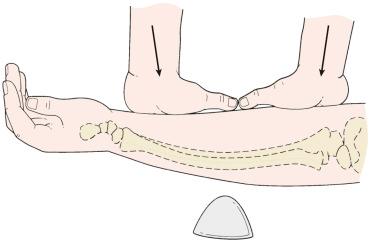
The elasticity of bone in children also explains its greater tendency for partial or unicortical fracture. Greenstick fractures are characterized by incomplete cortical fracture with angulation and rotation through plastic deformation of the remaining intact cortex. These fractures are commonly seen in children and are often noted in conjunction with a complete fracture of the other bone of the forearm. Diaphyseal fractures of the forearm are usually apex volar supination injuries ( Fig. 18.3 ) . Greenstick fractures are primarily a rotational deformity, although the radiographs are commonly misinterpreted as an angular deformity. As with any fracture, the degree of angular and rotational deformity must be assessed and treated accordingly. Apex volar fractures are supination deformity injuries requiring pronation for reduction. Conversely, less common apex dorsal fractures are pronation deformity injuries requiring supination for reduction. Greenstick fracture patterns are inherently more stable than complete fracture patterns after reduction. As such, they are usually treated with cast immobilization in the appropriate corrective rotation with molding to maintain the interosseous space and a straight ulnar border.
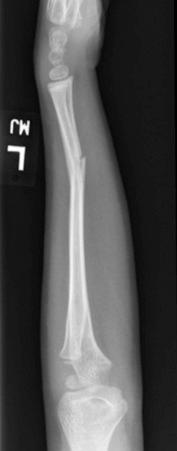
The greater mechanical stability of greenstick fractures may also result in greater difficulty when a reduction is required. In the case of both-bone forearm fractures, greenstick fracture of the ulna in association with a complex fracture of the radius may act not only as a contributor to the deformity but also as a potential block to reduction. Several authors have advocated “completion” of the greenstick fracture to facilitate the ease of reduction. Others have suggested that this is not necessary and adds unwanted instability to the fracture. Long-term data on this subject are lacking, and this approach remains controversial. Most would agree that the completion of greenstick fractures is acceptable and appropriate when necessary for achieving an anatomic reduction.
Greater force of injury results in the complete disruption of cortical bone. In the forearm, this typically involves both bones but may involve a single bone in conjunction with greenstick fracture or plastic deformation of the other. True single-bone forearm fractures do occur and are typically the result of a direct blow. Single-bone forearm fractures in the setting of an axial load are rare and should raise the suspicion of an injury to the proximal or distal radioulnar joint (e.g., Monteggia or Galeazzi fracture, respectively) ( Fig. 18.4 ). Complete fractures usually occur in older children and are inherently more unstable after reduction.
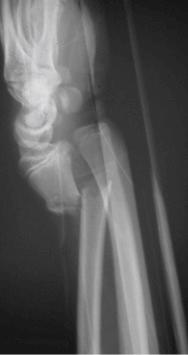
The need for emergent treatment of diaphyseal forearm fractures is rare. Those fractures that are associated with a neurovascular injury or are complicated by a developing compartment syndrome qualify for true emergent treatment. Otherwise, most forearm fractures can be treated with appropriate urgency to stabilize the injury. This can be completed temporarily with a splint in the emergency department before evaluation for definitive management. Recently, some have advocated for the treatment of Gustilo grade I open fractures with local débridement, administration of antibiotics, and closed reduction and casting in the emergency room forgoing the typical formal operative irrigation and débridement.
The goals of treatment include the safe and expedient correction of bone length, angulation, and rotation to as anatomic a position as possible within acceptable standards of anticipated remodeling; anatomic reductions of joint dislocations; maintenance of reduction until adequate healing has occurred; and appropriate treatment of soft tissue injuries. Nondisplaced stable fractures are treated with brief immobilization for comfort and prevention of recurrent injury during the healing phase. Displaced fractures and dislocations in the forearm are most often treated with closed reduction and cast immobilization. Operative intervention is indicated when adequate reduction cannot be achieved or maintained by closed means. Frequently used methods depending on the clinical situation include closed reduction and percutaneous pinning, percutaneous or open intramedullary rodding, and open reduction-internal fixation with the use of plates and screws. External fixation is less commonly used in children.
The majority of fractures and dislocations involving the forearm can be treated nonoperatively. The rapid healing, the remodeling potential of children’s bones in the planes of motion of the adjacent joints, and their tolerance for immobilization make cast-splint management the treatment of choice in most cases. Proper technique in reduction and immobilization is critical for successful treatment.
Displaced fractures, dislocations, and fracture-dislocations require reduction before immobilization. Manual manipulation of the extremity can range from gentle traction to vigorous and forceful re-creation of the injury mechanism for deformity correction, depending on the fracture location and degree of deformity. Determining whether a fracture reduction is necessary is of paramount importance. This decision is based on acceptable standards reported in the literature for expected specific injury outcomes as they relate to fracture displacement, joint dislocation or subluxation, fracture location (i.e., metaphyseal, diaphyseal, or epiphyseal), and the potential for remodeling (i.e., skeletal age of the patient, proximity to an open physis, and the plane of deformity relative to that of the proximate joints).
Once the determination has been made that the present fracture alignment is unacceptable, the patient is prepared for a reduction maneuver. In most children, this requires some level of anesthesia. In smaller children, this may be in the form of conscious sedation administered in the emergency department setting. This usually entails a combination of analgesic and amnestic medications such as ketamine, narcotics, and/or benzodiazepines. Conscious sedation should only be administered to children in a monitored setting by an experienced pediatrician or anesthesiologist who is certified in pediatric advanced life support. Oxygen, reversal agents, and equipment for emergency airway management must be made available before administration of sedation. For more complex cases or anticipated prolonged procedures, formal administration of a general anesthetic in the operating room is considered to be safer and a more controlled option. Adolescents approaching adulthood may not require sedation for closed reductions, particularly of distal radial metaphyseal and physeal fractures. A hematoma block or intrafracture local anesthetic injection may suffice for closed reductions in the emergency department in this age group.
Once the patient is adequately and safely sedated or anesthetized, the reduction maneuver is performed. Proper technique is essential for a successful reduction. The techniques used for reduction maneuvers vary greatly, depending on the specific injury pattern. However, some general principles apply to all reduction maneuvers. The patient must be positioned in such a way as to provide the surgeon optimal mechanical advantage and access to the extremity. Aid from a qualified assistant can be invaluable and should be sought if and when resources allow. Prereduction and postreduction neurovascular examination and documentation should be considered part of every reduction maneuver. Portable image intensification should be used when available. Casting or splinting materials should be collected and prepared as completely as possible before reduction. Some surgeons prefer to apply stockinette or even cast padding before reduction in an effort to minimize the risk of loss of reduction during cast application. The surgeon must then be prepared to safely apply the necessary amount of force to achieve reduction. This may range from only gentle axial traction to forceful manipulation. An understanding of the exact amount of force that is both necessary and safe is gained only by practical experience and reduction maneuvers performed under supervision whenever possible. In children, a partially intact layer of periosteum may act as a tether that indirectly blocks reduction, necessitating the re-creation of the injury mechanism with intentional exaggeration of angulation to “unhook” the fracture. This allows subsequent unfettered rotation at the fracture site around a hinge of intact periosteum. When the correct technique is used to unhook the fracture, this hinge of periosteum can act as an aid in reduction by preventing complete displacement, guiding the reduction to a more anatomic position, and adding stability to the injury pattern as a tension band. Attempts should be made to keep any remaining periosteum intact. The “three-point” cast molding technique exploits the fulcrum created by the partially intact periosteum to provide added stability to the reduction and subsequent immobilization. Muscle spasm and contracture may contribute to fracture deformity. Relaxation can be achieved by steady longitudinal traction applied over time, which eventually results in muscle fatigue and gradual lengthening. Older children may tolerate elevation in finger traps with 5 to 10 pounds of weight suspended around the upper arm. Intravenous muscle relaxants are rarely necessary. The goal of closed reduction is anatomic alignment with correction of translation, malrotation, and angulation. This lessens the risk of unacceptable loss of reduction over the ensuing 3 to 4 weeks of fracture healing.
Unacceptable reduction is generally considered to be greater than 20 degree angulation with 2 years or less of growth remaining. However, in the proximal forearm, malalignment of greater than 10 to 15 degrees may not remodel and may thus impair forearm rotation permanently. Bayonet apposition has been thought to be acceptable up to 8 to 10 years of age, as long as angulation and malrotation are corrected. In the case of unexpectedly difficult reductions, the surgeon must entertain the possibility of interposed tissues such as periosteum, muscle, tendon, or neurovascular structures. Interposed structures may render anatomic reduction impossible, necessitating surgical exploration. Particular caution is necessary when reduction of displaced physeal fractures is attempted. This should be limited to one or two gentle closed reduction attempts, and forceful manipulation of the physis should be avoided, if possible. Repeated attempts at reduction of physeal injuries may result in iatrogenic physeal injury and growth arrest.
The majority of forearm fractures, whether proximal or diaphyseal, should be immobilized in a long arm cast or splint. Important molding characteristics include (1) well-contoured supracondylar humeral molds, (2) well-contoured interosseous forearm molds, (3) three-point molding techniques, (4) allowance of appropriate elbow flexion, and (5) a straight ulnar border. If circumferential casting is the preferred immobilization technique, the author prefers to bivalve the cast to decrease pressure and allow for swelling without compromising the maintenance of the reduction. Poor casting technique can result in unnecessary loss of reduction and can place the patient at higher risk of cast-related complications such as skin breakdown and cast-saw burns ( Fig. 18.5 ).
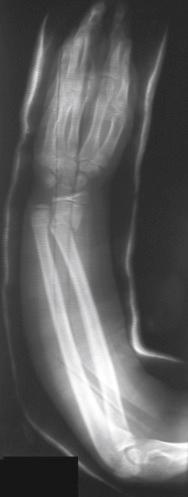
Nondisplaced fractures should be casted with the elbow in 90 degrees of flexion and the forearm in neutral rotation. Displaced fractures requiring reduction should also be casted with the elbow flexed 90 degrees, but forearm rotation may be one of supination or pronation (more common), depending on the fracture pattern and the stable position after reduction. Cast immobilization is usually continued for 4 to 6 weeks, depending on evidence of radiographic healing. Frequent radiographs, usually weekly for up to 3 weeks, should be obtained for fractures requiring reduction so that acceptable alignment is maintained.
Surgical treatment of forearm fractures is reserved for those fractures that are irreducible by closed means or that fail closed management because of loss of reduction, open fracture type, refracture, segmental injury pattern, ipsilateral humerus fractures (“floating elbow” injuries), or compartment syndrome complications.
A thorough understanding of the development of the radius and ulna and their articulation is essential for treating injuries to the growing forearm. Familiarity with normal ages of ossification and locations of all secondary growth centers, as well as the expected growth potential and age at fusion of all physes, is also essential for the protection of the immature physis and nonossified epiphyses when injuries are being treated. It is important to note that epiphyses form initially as cartilaginous structures, only to ossify secondarily with further growth. It is critical to remain cognizant of the fact that these structures can be significantly injured before ossification with little radiographic evidence of injury.
The radius and ulna form from primary ossification centers that appear during the eighth week of gestation. Secondary ossification centers, or epiphyses, later begin to ossify at the proximal end of the radius in the fifth to seventh year and in the proximal ulna in the ninth to tenth years. The distal epiphysis of the radius ossifies during the first year in girls and shortly after 1 year in boys. The distal ulnar epiphysis, however, does not begin to ossify until approximately age 6 in boys and girls ( Table 18.1 ). Note that either the distal radial or ulnar epiphyses may occasionally develop from two distinct ossification centers and should not be mistaken for fracture of the radial or ulnar styloids. Distal radial and ulnar physes typically fuse in the sixteenth to eighteenth year. Girls’ physes generally fuse earlier than boys’ physes.
| Ossification | Physeal Closure | |||
|---|---|---|---|---|
| Growth center | Boys | Girls | Boys | Girls |
| Proximal radius | 5–7 | 5–7 | 16–18 | 16–18 |
| Distal radius | 1–1.5 | <1 | 18–19 | 17 |
| Proximal ulna | 9–10 | 9–10 | 16–18 | 16–18 |
| Distal ulna | 6 | 6 | 17–18 | 16–17 |
| Primary radius | 8 weeks | 8 weeks | ||
| Primary ulna | 8 weeks | 8 weeks | ||
The forearm is composed of the radius and ulna. They articulate with one another at both the proximal (PRUJ) and distal radioulnar joints (DRUJ). The interosseous membrane provides a fibrous attachment between the two bones along their length ( Fig. 18.6 ). At the elbow, the radius and ulna articulate with the capitellum and the trochlea of the humerus, respectively. At the wrist, the radius and ulna articulate with the proximal row of the carpus (i.e., scaphoid, lunate, and triquetrum from radial to ulnar). In cross section, the radius is cylindrical proximally, becomes triangular in its middle third, and is broader and more elliptical distally. The radius has a physiologic bow in the radial and posterior direction with the forearm in supination, which creates the interosseous space and is critical for forearm rotation. It is stabilized proximally by the annular ligament, the PRUJ and the quadrate ligament, proximal fibers of the interosseous membrane, lateral collateral ligaments of the elbow, and the osseous constraints of the radiocapitellar joint. The radial head and radial styloid are palpable proximally and distally, respectively. Just distal to the radial neck, the biceps tendon attaches to the bicipital tuberosity, which points anteriorly in supination and posteriorly in pronation. This can be a useful landmark radiographically for assessing rotational deformities and loss of the anatomic bow. Lister’s tubercle is a dorsal prominence on the distal aspect of the radius, which can also serve as a useful landmark clinically and radiographically. The extensor pollicis longus (EPL) passes ulnar to Lister tubercle and can be injured by fracture fragments or internal fixation techniques. The ulna is triangular in cross section and has a straight border and small posterior bow in its proximal third. It is statically stabilized proximally by the osseous constraints of the trochlea, the PRUJ, and the medial and lateral collateral ligaments of the elbow. The coronoid and olecranon processes form the trochlear notch of the ulna, providing the osseous stability of the ulnohumeral articulation. Distally, the ulna is stabilized by the DRUJ and the attachments of the triangular fibrocartilage complex (TFCC). The ulnar styloid is a palpable prominence at the distal ulnar aspect of the ulna.
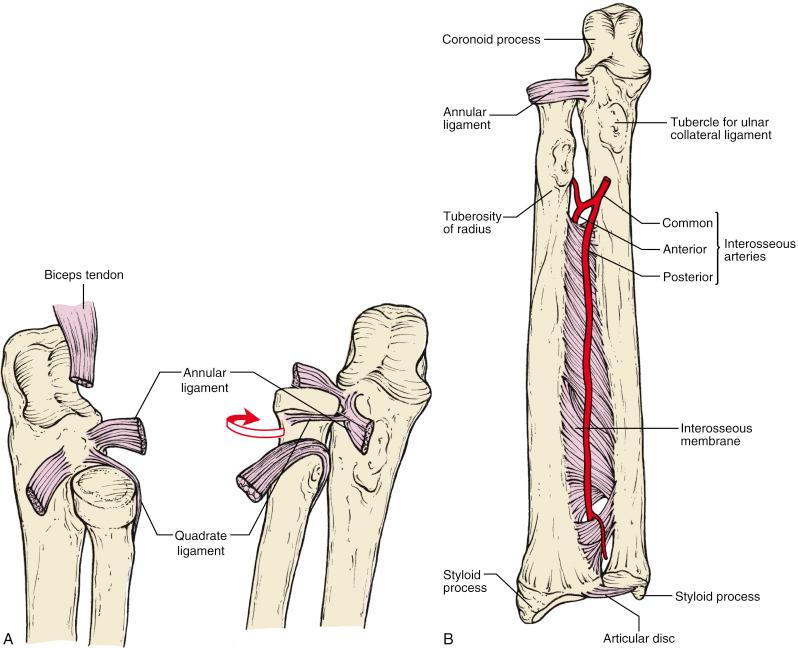
The head of the radius sits in the radial notch of the ulna. It is stabilized in this position by the annular ligament, which encases the radial head nearly circumferentially and has fibrous attachments both to the ulna and to the medial and lateral collateral ligaments of the elbow. The joint capsule and the oblique cord, which runs from the base of the coronoid process to just distal to the radial tuberosity, provide additional stability. The quadrate ligament is a stout and flat band that lies deep to the annular ligament on the anterior aspect of the PRUJ, extending from the base of the coronoid to the radial neck. Similar to the interosseous membrane, it tightens with supination of the radius, stabilizing the radial head in the notch of the ulna. Finally, during supination, the broadest area of the radial head is in contact with the radial notch of the ulna. It is for these reasons that the PRUJ is most stable in forearm supination. Injury to these structures can be seen in Monteggia fractures, elbow dislocations, and radial head fracture-dislocations.
This flat, fibrous layer runs from the medial border of the radius to the lateral border of the ulna. It extends from a level 1 cm distal to the radial tuberosity distally to the DRUJ. The obliquely oriented fibers run from the radius directed distally to the ulna at an angle of approximately 60 degrees. The membrane is most taut in neutral to 30 degrees of supination and relaxes in pronation and terminal supination. The interosseous membrane is important in the mechanics of forearm rotation, stabilization of the PRUJ, and in resistance of proximal migration of the radius relative to the ulna. It also serves as a useful surgical landmark for demarcating the anterior and posterior compartments of the forearm. The Essex-Lopresti lesion is characterized by radial head fracture with associated rupture of the interosseous membrane. In these injuries, the DRUJ can be injured or unstable because of loss of bone and soft tissue constraints related to proximal migration of the radius.
The volar and dorsal radioulnar ligaments, the ulnar collateral ligament of the wrist, and the attachments of the TFCC stabilize the DRUJ. The carpal ligaments contribute stability to the DRUJ and will be discussed under anatomy of the wrist. It is important to understand the relationship between the DRUJ and the TFCC and to recognize that an injury to one often suggests an injury to the other.
The TFCC consists of the triangular fibrocartilage and the ulnocarpal ligaments, serving as an important stabilizer of the DRUJ and ulnar aspect of the wrist. It also serves as a cushion to ulnotriquetral impaction during ulnar deviation of the wrist. The TFCC is a fibrocartilaginous disk similar to the meniscus of the knee. It is thicker and more vascular at its periphery but thinner and relatively avascular near its center. It has strong attachments to the volar and dorsal radioulnar ligaments and the ulnar collateral ligament of the wrist. At the periphery, it has attachments to the joint capsule. It spans the DRUJ, separating the carpal articular surface from the notch of the ulna. Extending from the ulnar aspect of the radial articular surface, it covers the distal aspect of the ulna with peripheral attachments at the joint capsule, the base of the ulnar styloid, and the ulnar collateral ligament of the wrist.
Injuries to the DRUJ may occur in isolation or may be seen in combination with a fracture such as in a Galeazzi fracture (DRUJ dissociation with radial shaft fracture) or Essex-Lopresti lesions (DRUJ injury in association with radial head fracture and interosseous membrane disruption).
With forearm rotation, the radius rotates, or “radiates,” around the ulna and around a longitudinal axis centered through the radiocapitellar joint proximally and the center of the ulna distally. Rotation of the radius about the ulna has been described as forming a half-cone of approximately 150 to 180 degrees. The radial head pivots within the annular ligament. With forearm supination, the quadrate ligament tightens across the anterior aspect of the PRUJ, and the volar radioulnar ligament tightens across the DRUJ.
It is critical to understand the significance of the interosseous space and membrane in forearm rotation. Cadaveric studies have shown that the diameter of the interosseous space and the tension across the interosseous membrane change with forearm rotation. At neutral to 30 degrees of supination, the interosseous space is at its greatest diameter, and the membrane is most taut. The interosseous space decreases with pronation and at extremes of supination, and the membrane tension decreases accordingly. The radial bow is normally in the radial and dorsal direction. A loss of this anatomic bow can effectively decrease the diameter of the interosseous space ( Fig. 18.7 ). As a result, significant pronation may be lost secondary to radioulnar impingement at terminal pronation. The most common cause of loss of range of motion after a forearm fracture is a loss of rotation secondary to a failure to restore the anatomic bow of the radius. In malreduced proximal fractures, the bicipital tuberosity may impinge on the ulna.
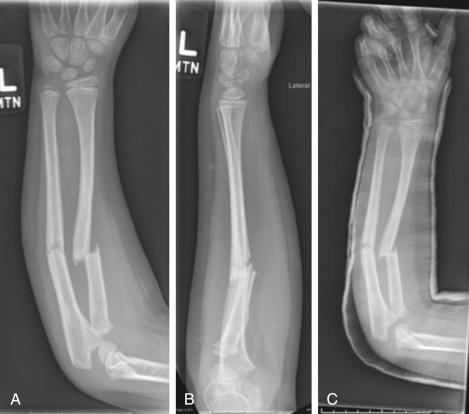
For procedures performed on the forearm, the patient is best positioned supine on the operating room table with the injured extremity extended onto a hand table. A tourniquet is useful for obtaining a bloodless operative field. Surgeon preference denotes the use of a sterile versus a nonsterile tourniquet across the upper brachium. The image intensifier is often placed perpendicular to the operating room table and parallel to the operative extremity to allow the surgeon and an assistant unimpeded access to the operative field.
The anterior approach to the forearm, also commonly referred to as the Henry approach ( Table 18.2 ), is a workhorse for the upper extremity surgeon ( Fig. 18.8 ). This extensile approach provides excellent exposure of the radius from the wrist to the elbow. It may also be extended across the elbow and carried proximally in the anterior approach to the upper arm and shoulder. Theoretically, the upper extremity osseous structures can be exposed from the wrist to the shoulder through one incision with the use of this approach. Five muscles must be detached from the anterior aspect of the radius to expose it in its entirety. From proximally to distally, they are the supinator, pronator teres, flexor digitorum superficialis (FDS), flexor pollicis longus (FPL), and pronator quadratus.
| Approach | Muscular Interval | Internervous Plane | Dangers |
|---|---|---|---|
| Anterior radius | Proximal: pronator teres and brachioradialis | Median and radial nerves | PIN, superficial radial nerve, radial artery |
| Distal: FCR and brachioradialis |
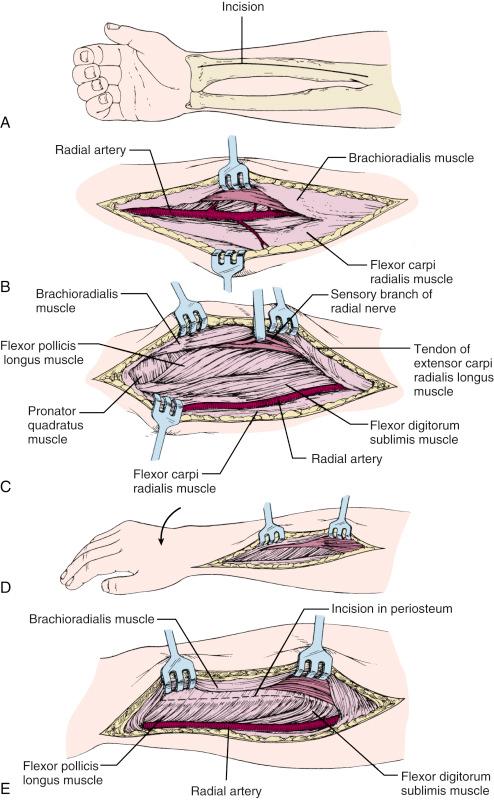
The anterior approach to the forearm exploits the internervous plane between the median and radial nerves. Proximally, this plane lies between the pronator teres (median nerve) and brachioradialis (radial nerve) muscles. Distally, the plane is between the flexor carpi radialis (FCR) (median nerve) and the brachioradialis. For incision location, the brachioradialis muscle and mobile wad are palpated on the radial forearm. Just medial to the brachioradialis and lateral to the biceps tendon, a linear longitudinal incision is initiated just distal to the elbow flexion crease and is carried distally toward the insertion of the FCR tendon, in line with the radial shaft. The dissection is carried down to the subcutaneous fascia. The lateral antebrachial cutaneous nerve may be visualized in the proximal aspect of the wound and must be protected.
In the proximal third, the interval between the pronator teres and the brachioradialis is identified. The fascia is incised in line with these fibers, and the interval is bluntly defined. A collateral branch of the radial artery, known as the recurrent leash of Henry, is often encountered in this interval and must be ligated so that the brachioradialis can be mobilized laterally. The radial artery can then be retracted medially. The next muscle encountered is the supinator, which is easily identified by the transverse course of its fibers. Great care must be taken during this portion of the exposure to avoid injury to the posterior interosseous nerve (PIN). The radial nerve, which runs between the brachialis and brachioradialis muscles in the distal humerus, branches just below the elbow into the superficial (sensory) and posterior interosseous (motor) branches. The superficial branch continues distally between the brachioradialis and extensor carpi radialis longus (ECRL) muscles and should be mobilized laterally with the brachioradialis. It pierces the fascia to become subcutaneous roughly 5 to 7 cm above the wrist. The PIN travels medially and posteriorly, passing under the fibrous leading edge of the supinator, known as the arcade of Frohse, and splitting the two heads of the supinator muscle. Not all patients have two heads of the supinator muscle; thus, the nerve can lie directly on the periosteum, where it is at greatest risk of injury. It then traverses the muscle, wrapping posteriorly around the radial neck and proceeding distally across the origin of the abductor pollicis longus (APL) muscle along the posterior aspect of the interosseous membrane. It is also at this level that the PIN is at greatest risk of injury during the anterior approach. It runs in very close proximity to the radius at this level and may be difficult to visualize through the supinator. Supination of the forearm will move the PIN radially and posteriorly, displacing it from the incision and protecting it. The insertion of the supinator on the radius is then identified and elevated in a subperiosteal fashion, moving circumferentially from medial to lateral, and carefully posteriorly around the radial neck. It is critical that the supinator be elevated subperiosteally to protect the PIN. Even gentle retraction of the supinator on the radial aspect of the radius can result in neurapraxia of the PIN and should be avoided whenever possible. Blind placement of retractors on the radial and posterior aspect of the proximal radius puts the nerve at risk and is not recommended. Subperiosteal exposure of the radius can then be safely carried distally.
The anterior middle third of the radius is covered by the insertion of the pronator teres and the origin of the FDS tendons. Pronation of the forearm at this point exposes the lateral insertion of the pronator on the radius. The pronator and FDS can then be elevated from proximal to distal in a subperiosteal fashion. Distal to the pronator teres insertion the superficial plane lies between the brachioradialis and the FCR. Many surgeons incise the floor of the sheath of the FCR tendon longitudinally. The radial artery is identified and usually mobilized laterally. This reveals the pronator quadratus and FPL attachments to the anterior aspect of the distal radius. With the forearm once again in supination, these muscles can be detached subperiosteally from the lateral aspect of the radius and retracted medially, providing excellent exposure of the distal third of the radius. A cuff of tissue should be preserved to allow repair of these muscles, whenever possible.
Occasionally, exploration of the ulnar nerve may be necessary in the forearm ( Table 18.3 and Figs. 18.9 and 18.10 ). It is useful for the upper extremity surgeon to be comfortable with this approach and to be knowledgeable of the course of the major nerves in the forearm. This approach exploits the space between the flexor carpi ulnaris (FCU) (ulnar nerve) and the FDS (median nerve). The ulnar nerve provides motor innervation to the FCU and the ulnar half of the flexor digitorum profundus (FDP) in the forearm and can be found lying between these two muscles running medial to the ulnar artery. Proximally in the upper arm, the ulnar nerve pierces the intermuscular septum from anterior to posterior to travel posterior to the medial epicondyle at the elbow, traveling beneath the leading edge of the FCU. Distally at the wrist, the ulnar nerve traverses the wrist through Guyon’s canal.
| Approach | Muscular Interval | Internervous Plane | Dangers |
|---|---|---|---|
| Ulnar nerve, anterior | FCU and FDS | Ulnar and median nerves | Ulnar nerve and artery |
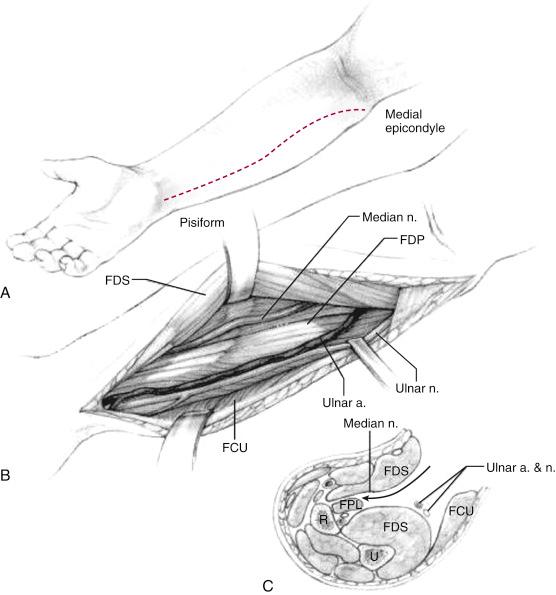
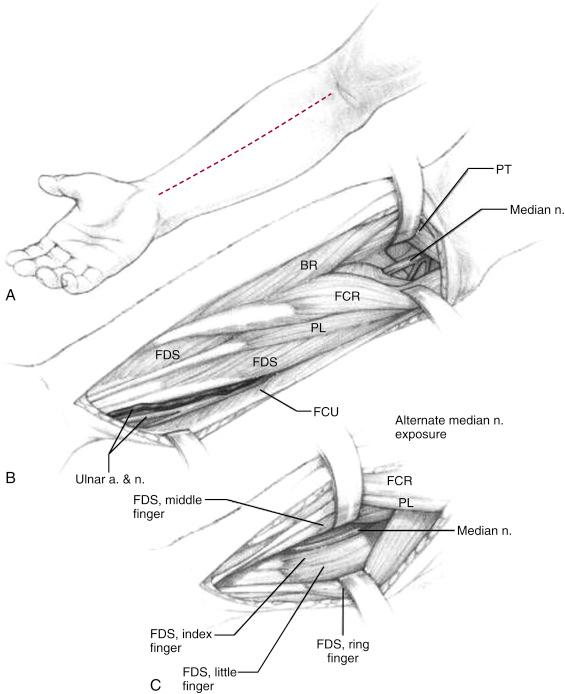
The posterior approach to the radius, also known as the Thompson approach ( Table 18.4 ), is another useful and commonly used approach to the radius ( Fig. 18.11 ). This approach is particularly useful for fractures of the proximal third of the radius because it allows enhanced exposure and visualization of the PIN, which is at risk in these fractures. It also provides exposure of the tension side of the bone, which is the optimal position for plate application. This approach exploits the internervous plane between the radial and posterior interosseous nerves because the dissection is performed proximally between the extensor carpi radialis brevis (ECRB) (radial nerve) and the extensor digitorum communis (EDC) (PIN). Distally, the plane lies between the ECRB and the EPL. A linear incision is made from just distal to the lateral epicondyle of the humerus, extending distally in line with the radius, and terminating on the ulnar side of the Lister tubercle of the radius. The fascia is split in line with its fibers. The interval between the ECRB and EDC is then identified. This plane can be more easily defined distally where the muscles of the first dorsal compartment (APL and extensor pollicis brevis) travel between the two. Dissection is carried from distal to proximal. Blunt dissection in the proximal aspect of the space reveals the underlying supinator muscle and its associated PIN. As in the anterior approach at this level, the PIN is at risk and must be protected. In contrast to the anterior approach, in the Thompson approach, the PIN is typically identified and dissected free. This is achieved with the forearm positioned in pronation. The nerve is then identified proximally or distally as it enters or exits between the deep and superficial heads of the supinator. The nerve exits approximately 1 cm proximal to the distalmost extent of the supinator. It may be necessary to detach the origins of the ECRB and ERCL so that the PIN may be visualized entering the supinator proximally. Once the nerve has been identified and protected, the forearm is supinated, and the supinator is elevated off the anterior aspect of the radius in a subperiosteal fashion, similar to that used in an anterior approach. Distally, the interval between the ECRB and EPL is exposed deep to the overlying APL and EPB. The distal radius can then be safely exposed in a subperiosteal fashion. The crossing APL and EPB can be mobilized proximally or distally to facilitate exposure of the interval and the underlying radius.
| Approach | Muscular Interval | Internervous Plane | Dangers |
|---|---|---|---|
| Radius, posterior | ECRB and EDC | Radial nerve and PIN | PIN |
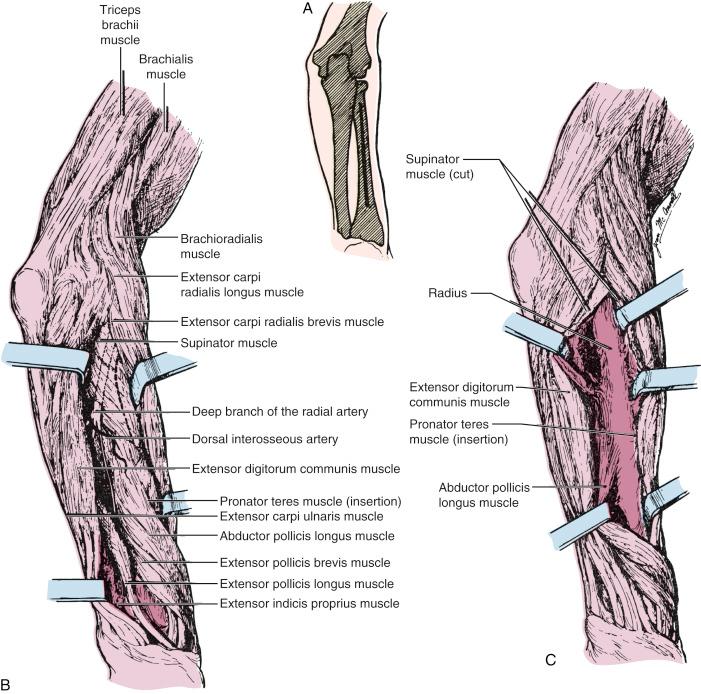
The Boyd approach ( Table 18.5 ) is unique because it allows the simultaneous exposure of the proximal radius and ulna ( Fig. 18.12 ). This distal extension of the posterolateral (Kocher) approach to the elbow is most useful for the treatment of Monteggia fractures and equivalent injuries. Proximally, it exploits the interval between the anconeus (radial nerve) and the extensor carpi ulnaris (ECU) (PIN) muscles. The dissection can be extended distally along the border of the ulna, with use of the space between the ECU (PIN) and the FDP (median nerve) and the FCU (ulnar nerve) more distally. Pronation of the forearm moves the PIN anteriorly and radially, displacing it from the wound and protecting it. The supinator can then be elevated from the ulna and retracted anteriorly and radially with the PIN safely protected in its substance. Vigorous retraction of the supinator and blind placement of retractors around the radius should be avoided. At this point, the annular ligament and anterior capsule of the elbow joint are exposed. Fractures of the proximal radius, ulna, or both may be treated at this point. Open reduction of the radial head and repair or reconstruction of the annular ligament may be performed. The surgeon must be aware of the close proximity of the median nerve and brachial artery as they cross the elbow joint on the anterior surface of the joint capsule medial to the biceps tendon. The radial nerve and its superficial branch are safely anterior in the interval between the brachialis and the brachioradialis muscles.
| Approach | Muscular Interval | Internervous Plane | Dangers |
|---|---|---|---|
| Radius and ulna, posterolateral | Proximal: anconeus and ECU Middle: FDS and ECU Distal: FCU and ECU |
Radial nerve and PIN Median nerve and PIN Ulnar nerve and PIN |
PIN, median nerve, brachial artery |
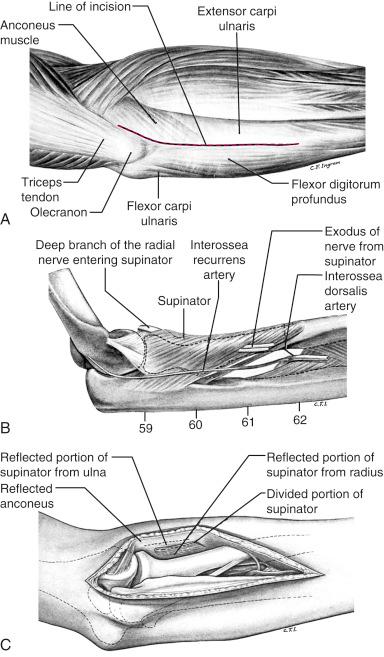
Exposure of the ulna is typically performed through a separate incision ( Table 18.6 ). The ulna is largely subcutaneous at its ulnar border, thus facilitating its rapid and safe exposure. In addition, neither the anterior nor the posterior approaches to the radius afford adequate exposure for safe and effective fixation of fractures of the ulna. The ulna can easily be exposed in its entirety along its subcutaneous border. This approach exploits the internervous plane between the FCU (ulnar nerve) and the ECU (PIN). A longitudinal incision is made over the subcutaneous border of the ulna. The plane between the FCU and ECU is confirmed, and the incision is carried directly down to the periosteum on the ulnar aspect of the bone. The ulna is then exposed in a subperiosteal fashion. Care must be taken not to inadvertently dissect on the lateral side of the FCU muscle. It is here that the ulnar nerve and artery travel in the space between the FCU and FDP muscles and are at risk of injury. These structures are also at risk during dorsal-to-volar–directed drilling and screw placement in the ulna and must be protected with careful subperiosteal retractor placement around the ulna.
| Approach | Muscular Interval | Internervous Plane | Dangers |
|---|---|---|---|
| Ulna, medial | ECU and FCU | PIN and ulnar nerve | Ulnar nerve |
Become a Clinical Tree membership for Full access and enjoy Unlimited articles
If you are a member. Log in here